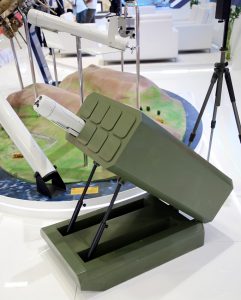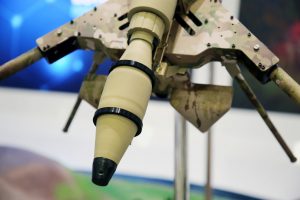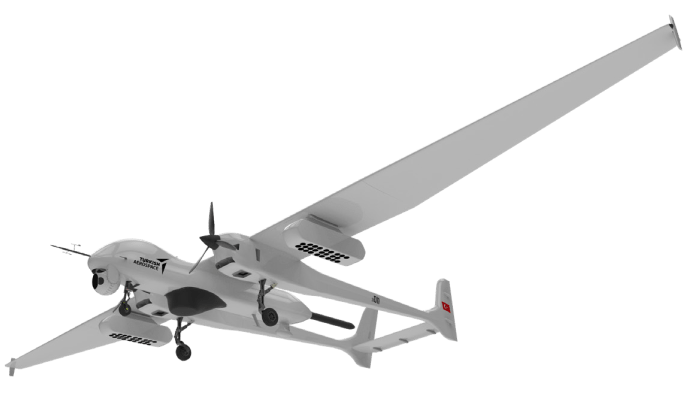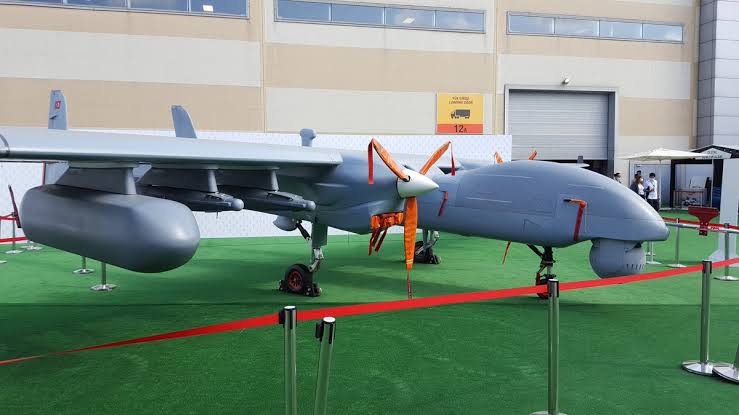I said long distances. Greece is very close. It is highly unlikely that this ship will be used in the initial phase of an possible operation against Greece, as there is no need. Maybe, as you said, it can be used after the point where air superiority is achieved. Therefore, the Hellennic Air Force better save the already scarce Scalp missiles for more important targets.Without air superiority? Not an easy target for the scalps?
Latest Thread
You are using an out of date browser. It may not display this or other websites correctly.
You should upgrade or use an alternative browser.
You should upgrade or use an alternative browser.
I said long distances. Greece is very close. It is highly unlikely that this ship will be used in the initial phase of an possible operation against Greece, as there is no need. Maybe, as you said, it can be used after the point where air superiority is achieved. Therefore, the Hellennic Air Force better save the already scarce Scalp missiles for more important targets.
for Greece navy in aegan see configuration air force is not needed at all just enough atmaca missiles on boats and land platforms. these carrier is planned as said is for power projection versus non state actors.
I said long distances. Greece is very close. It is highly unlikely that this ship will be used in the initial phase of an possible operation against Greece, as there is no need. Maybe, as you said, it can be used after the point where air superiority is achieved. Therefore, the Hellennic Air Force better save the already scarce Scalp missiles for more important targets.
It will be very easy for Greece to get Scalps from France
Were there any more Pantsirs hunted by TB2 lately?
It seems our Russian friends can't forget the Pantsir genocide!
Bf4 has pantsirs at the Russian base when you start the game.
Im just there staring at it and saying damn wouldnt it look better if it was roasted by a TB2
STM loitering munitions evolve
23/08/2021By Paolo Valpolini
With its Kargu rotary wing loitering munition in service with Turkish Land Forces since2018 and with an export customer since 2021, the system being now combat proven, and with its fixed wing Alpagu loitering munition to be delivered to Turkish Land Forces within this year, STM is continuously developing its products to keep up with its customers’ requirements.

click on image to enlarge
The Alpagu munition has been submitted to a weight-reduction programme, and thanks to improvements in avionics, mechanical parts and warhead its take-off weight is now 1.9 kg, the air vehicle and the pneumatic launch tube weighing 3.5 kg. The anti-personnel warhead of the production system weighs 300 grams and is made of plastic explosive with embedded an undisclosed number of 4 mm cubes adding fragmentation effect to the explosive one. The R&D department at STM is currently working on two new types of warheads for the Alpagu, a thermobaric and an armour piecing one. In the STM stand at IDEF 2021 the new multiple launcher was also exhibited; the one on show was an 8-cell system, with two rows of four tubes, however according to STM dedicated launchers with a different number of tubes can easily be produced. An external antenna was also exhibited, which allows doubling the range up to 10 km.

click on image to enlarge
This can also be used by the Kargu, the VTOL loitering munition, which also considerably evolved from the original design seen in 2017, some people relating to it as the Kargu 2. The endurance has been increased from slightly over 10 minutes to 30 minutes, the range is now close to 7 km and can be brought to 12 km using the aforementioned antenna.

click on image to enlarge
The standard anti-personnel payload has been redesigned, the warhead being now similar to that of the Alpagu, its weight being however much higher, up to 1.3 kg. The shape allows understanding that fragments would be spread on a quite wide angle, making it a sort of “flying Claymore”.

click on image to enlarge
As for the Alpagu, a thermobaric warhead is under development, and according to EDR On-Line sources it is nearly ready. Another version of the Kargu will feature a radio frequency seeker, working in the VHF/UHF band, coupled to an armour-piercing warhead. As stated by STM representatives, this will make the Kargu a “mini Harop”, citing the Israeli anti-radiation drone; however the latter is more oriented against air defence radars, while the frequency coverage of the Turkish system makes it more suitable against command centres, signal assets and command vehicles.
STM is developing new capabilities that will bring its loitering munitions to operate in swarms. To this end it is developing a number of features such a central/distributed communication infrastructure, inter-UAV communications, formation capability, sense and avoid capacity, targeting and prioritisation, and target sharing, in order to bring to bear effective swarm attacks. With increasing threats against satellite-based navigation systems, STM is also carrying out a development project, known as Kerkes, aiming at give its drones the ability to operate independently from GNSS systems.
Photos courtesy P. Valpolini

STM loitering munitions evolve - EDR Magazine
By Paolo Valpolini With its Kargu rotary wing loitering munition in service with Turkish Land Forces since2018 and with an
L
LegionnairE
Guest
@Pantelis
While everybody is confused about what TCG Anadolu is supposed to be, the Turkish Navy is not. The ship will be operated in it's original role, as an LHD.
Drones and helicopters are only there to support a landing operation. Theoratically, this could take place in Libya, Egypt, Cyprus or Crete.
It's a very big and expensive platform so it's going to have to be protected by other ships at all times.
As for power projection, she's probably never going to conduct operations far from Turkish Air Force's reach.
Aegean is a particularly dangerous sea for TCG Anadolu as it would be difficult to hide there, but landing operations are always dangerous. Just look at what happened in Gallipoli. That's why we used to conduct EFES exercises every year.
While everybody is confused about what TCG Anadolu is supposed to be, the Turkish Navy is not. The ship will be operated in it's original role, as an LHD.
Drones and helicopters are only there to support a landing operation. Theoratically, this could take place in Libya, Egypt, Cyprus or Crete.
It's a very big and expensive platform so it's going to have to be protected by other ships at all times.
As for power projection, she's probably never going to conduct operations far from Turkish Air Force's reach.
Aegean is a particularly dangerous sea for TCG Anadolu as it would be difficult to hide there, but landing operations are always dangerous. Just look at what happened in Gallipoli. That's why we used to conduct EFES exercises every year.
The KARGU kamikaze UAV information on the Gendarmerie General Command stand at IDEF'21 is different from the catalog. Range information is given as 20 km.
Kargu will be a menace on the battlefield. That RPG warhead can make short work of armored vehicles with top attack and capability to select the point of impact. Kargu-RF will look for V/UHF signal sources. Kargu RPG will hunt armored vehicles and Kargu Claymore will hunt soft targets. They all work together in a swarm. Overwhelming capability.
The first batch of 6 Akıncı UCAVs is going to be delivered on 29 August with the ability to drop MAM-T, MAM-L, and MAM-C. Akıncı will gain the capability to carry MK series of bombs before the end of this year. Air to air missile and SOM tests are planned for 2022. AESA radar integration works will start on the Akıncı by the end of this year. We will see the first AESA radar on F-16s by the end of 2022. F-16 and Akıncı AESA radar projects will end by the end of 2022. A state-of-the-art airborne AESA radar will be developed in 48 months( end of 2018 to end of 2022). Serial modernization of F-16s will start in 2023.
The first batch of 6 Akıncı UCAVs is going to be delivered on 29 August with the ability to drop MAM-T, MAM-L, and MAM-C. Akıncı will gain the capability to carry MK series of bombs before the end of this year. Air to air missile and SOM tests are planned for 2022. AESA radar integration works will start on the Akıncı by the end of this year. We will see the first AESA radar on F-16s by the end of 2022. F-16 and Akıncı AESA radar projects will end by the end of 2022. A state-of-the-art airborne AESA radar will be developed in 48 months( end of 2018 to end of 2022). Serial modernization of F-16s will start in 2023.
I bet TCG is for possible Africa „missions“.@Pantelis
While everybody is confused about what TCG Anadolu is supposed to be, the Turkish Navy is not. The ship will be operated in it's original role, as an LHD.
Drones and helicopters are only there to support a landing operation. Theoratically, this could take place in Libya, Egypt, Cyprus or Crete.
It's a very big and expensive platform so it's going to have to be protected by other ships at all times.
As for power projection, she's probably never going to conduct operations far from Turkish Air Force's reach.
Aegean is a particularly dangerous sea for TCG Anadolu as it would be difficult to hide there, but landing operations are always dangerous. Just look at what happened in Gallipoli. That's why we used to conduct EFES exercises every year.
The first Bayraktar AKINCI TİHA will be delivered tomorrow
• 40 thousand feet altitude, 6 tons take-off weight, 1.5 tons payload capacity
• 40 thousand feet altitude, 6 tons take-off weight, 1.5 tons payload capacity
Since the first Akinci UCAV will be delivered tomarrow, I was reading through the wikipedia page of Bayraktar Akıncı in order to check sth while discussing with this youtube person and while reading I realised this phrase in the wiki page:
''Akıncı will be the first UAV capable of launching an ALCM.[11][12] [13][14]''
Is this bias? Why would Akinci be the first UCAV to launch ALCMs? What is holding back other similiar UCAVs like Eitan (or Reaper and Avenger for that matter)?
I would be glad if @500 or @Jacop could answer. I feel like this statement can be bias because I dont see a reason. Does carrying ALCMs require a specific technology for the aircraft? Or did Israel and USA just thought it is an unnecessary feature for UCAVs? Because a similiar arguement was also made when it was told Akinci will be the only UCAV out there to have AESA radar and air to air combat ability(though actually Avenger also has but it is kind of experimental).
I need some enlightenment.
''Akıncı will be the first UAV capable of launching an ALCM.[11][12] [13][14]''
Is this bias? Why would Akinci be the first UCAV to launch ALCMs? What is holding back other similiar UCAVs like Eitan (or Reaper and Avenger for that matter)?
I would be glad if @500 or @Jacop could answer. I feel like this statement can be bias because I dont see a reason. Does carrying ALCMs require a specific technology for the aircraft? Or did Israel and USA just thought it is an unnecessary feature for UCAVs? Because a similiar arguement was also made when it was told Akinci will be the only UCAV out there to have AESA radar and air to air combat ability(though actually Avenger also has but it is kind of experimental).
I need some enlightenment.
Do you know when Aksungur will be delivered?The first Bayraktar AKINCI TİHA will be delivered tomorrow
• 40 thousand feet altitude, 6 tons take-off weight, 1.5 tons payload capacity
Since the first Akinci UCAV will be delivered tomarrow, I was reading through the wikipedia page of Bayraktar Akıncı in order to check sth while discussing with this youtube person and while reading I realised this phrase in the wiki page:
''Akıncı will be the first UAV capable of launching an ALCM.[11][12] [13][14]''
Is this bias? Why would Akinci be the first UCAV to launch ALCMs? What is holding back other similiar UCAVs like Eitan (or Reaper and Avenger for that matter)?
I would be glad if @500 or @Jacop could answer. I feel like this statement can be bias because I dont see a reason. Does carrying ALCMs require a specific technology for the aircraft? Or did Israel and USA just thought it is an unnecessary feature for UCAVs? Because a similiar arguement was also made when it was told Akinci will be the only UCAV out there to have AESA radar and air to air combat ability(though actually Avenger also has but it is kind of experimental).
I need some enlightenment.
Every country needs modifications for its needs and these needs create their concepts. Israel's combat radius is generally limited and does not need it. If we needed it, we'd see a lot of different arguments on our UAVs.
Since the first Akinci UCAV will be delivered tomarrow, I was reading through the wikipedia page of Bayraktar Akıncı in order to check sth while discussing with this youtube person and while reading I realised this phrase in the wiki page:
''Akıncı will be the first UAV capable of launching an ALCM.[11][12] [13][14]''
Is this bias? Why would Akinci be the first UCAV to launch ALCMs? What is holding back other similiar UCAVs like Eitan (or Reaper and Avenger for that matter)?
I would be glad if @500 or @Jacop could answer. I feel like this statement can be bias because I dont see a reason. Does carrying ALCMs require a specific technology for the aircraft? Or did Israel and USA just thought it is an unnecessary feature for UCAVs? Because a similiar arguement was also made when it was told Akinci will be the only UCAV out there to have AESA radar and air to air combat ability(though actually Avenger also has but it is kind of experimental).
I need some enlightenment.
First with cruisemissiles and air to air missiles. Beside that first AESA radar....
Akinci will be first in his kind.
Wrong, MQ-1 had Stingers in the early 2000s.air to air missiles
Wouldn't Aksungur be more logical for MIT? With longer endurance.AKINCI 'll also enter the inventory of the National Intelligence Organization(MIT)
Wouldn't Aksungur be more logical for MIT? With longer endurance.
MIT is also logical but Aksungur's main mission profile will be shaped around the Turkish Navy. More than 60h (serial production standard variant) on air(30h with 12 MAM-L), The Turkish seas will be monitored 24/7.

The serial production variant is much more handsome and several hundred kg lighter than prototypes. Sonobuoy pods will be integrated for Navy's Aksungur.












